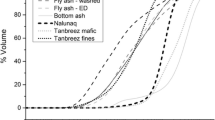It is shown that in order to produce acid-resistant brick based on production waste without the use of traditional raw material the optimum content of light ash fraction is about 50%. This brick has high physico-mechanical properties.



Similar content being viewed by others
References
V. Z. Abdrakhimov and E. S. Abdrakhimova, “Ecological aspects of the use of waste products and their classification of suitability for brick manufacture,” Ékol. Prom. Rossii, No. 6, 41 – 43 (2009).
E. S. Abdrakhimova, A. A. Buryi, V. Z. Abdrakhimov, et al., Ecology and Use of Technogenic Raw Material in the Production of Structural Ceramic Materials [in Russian], Samara State Arch.-Building Univ., Samara (2005).
V. Z. Abdrakhimov, Ecology and Utilization of Technogenic Deposits in the Production of Composite Ceramic Materials [in Russian], Samara Academy of State and Municipal Management, Samara (2010).
E. S. Abdrakhimova, and V. Z. Abdrakhimov, “Processes that occur during firing of the argillaceous part of zircon-ilmenite ore gravitation tailings,” Refr. Ind. Ceram., 50, No. 2, 101 – 106 (2009).
E. S. Abdrakhimova. “Structure formation of acid-resistant refractories with firing of the argillaceous part of zircon-ilmenite ore gravitation tailings,” Refr. Ind. Ceram., 50, No. 5, 12 – 15 (2009).
E. S. Abdrakhimova, Physicochemical Processes During Acid-Resistant Refractory Firing [in Russian], Nedra, St Petersburg (2003).
V. Z. Abdrakhimov and E. S. Abdrakhimova, Physicochemical Processes of Structure Formation in Ceramic Materials Based on Nonferrous Metallurgy and Power Generation Wastes [in Russian], West.-Kazakh. Techn. Univ., Ust’-Kamenogorsk (2000).
V. Z. Abdrakhimov, Study of the Effect of Iron-Containing Traditional and Technogenic Raw Material on Refractory Material Sintering. Effect of Fe 2+ and Fe 3+ Ions on Low-Temperature Mullite Formation [in Russian], Samara State Arch.-Building Univ., Samara (2009).
E. S. Abdrakhimova and V. Z. Abdrakhimov, “Physicochemical processes during firing of acid-resistant refractories based on technogenic raw material,” Izv. Vyssh. Uchebn. Zaved., Khim. Khim. Tekhnol., No. 10, 52 – 55 (2006).
E. S. Abdrakhimova, “Structural transformations of iron compounds in argillaceous materials according to Mossbauer spectroscopy data,” Zh. Fiz. Khim., 80, No. 7, 108 (2006).
V. Z. Abdrakhimov, “Formation of light ash fraction and prospects for its use in ceramic plate production,” Kompl. Ispol. Min. Syr’ya, No. 6, 75 – 78 (1988).
V. Z. Abdrakhimov, Effect of light ash fraction on ceramic plate properties,” Kompl. Ispol. Min. Syr’ya, No. 7, 75 – 80 (1988).
V. Z. Abdrakhimov and E. S. Abdrakhimova, “Optimization of light ash fraction content in ceramic mix compositions,” Steklo Keram., No. 3, 26 – 27 (2006).
Author information
Authors and Affiliations
Additional information
Translated from Novye Ogneupory, No. 5, pp. 41 – 44, May 2011.
Rights and permissions
About this article
Cite this article
Abdrakhimov, V.Z., Abdrakhimova, E.S. Ecological aspects of the use of light ash fraction and nonferrous metallurgy waste in the production of acid-resistant brick. Refract Ind Ceram 52, 231–234 (2011). https://doi.org/10.1007/s11148-011-9402-1
Received:
Published:
Issue Date:
DOI: https://doi.org/10.1007/s11148-011-9402-1




